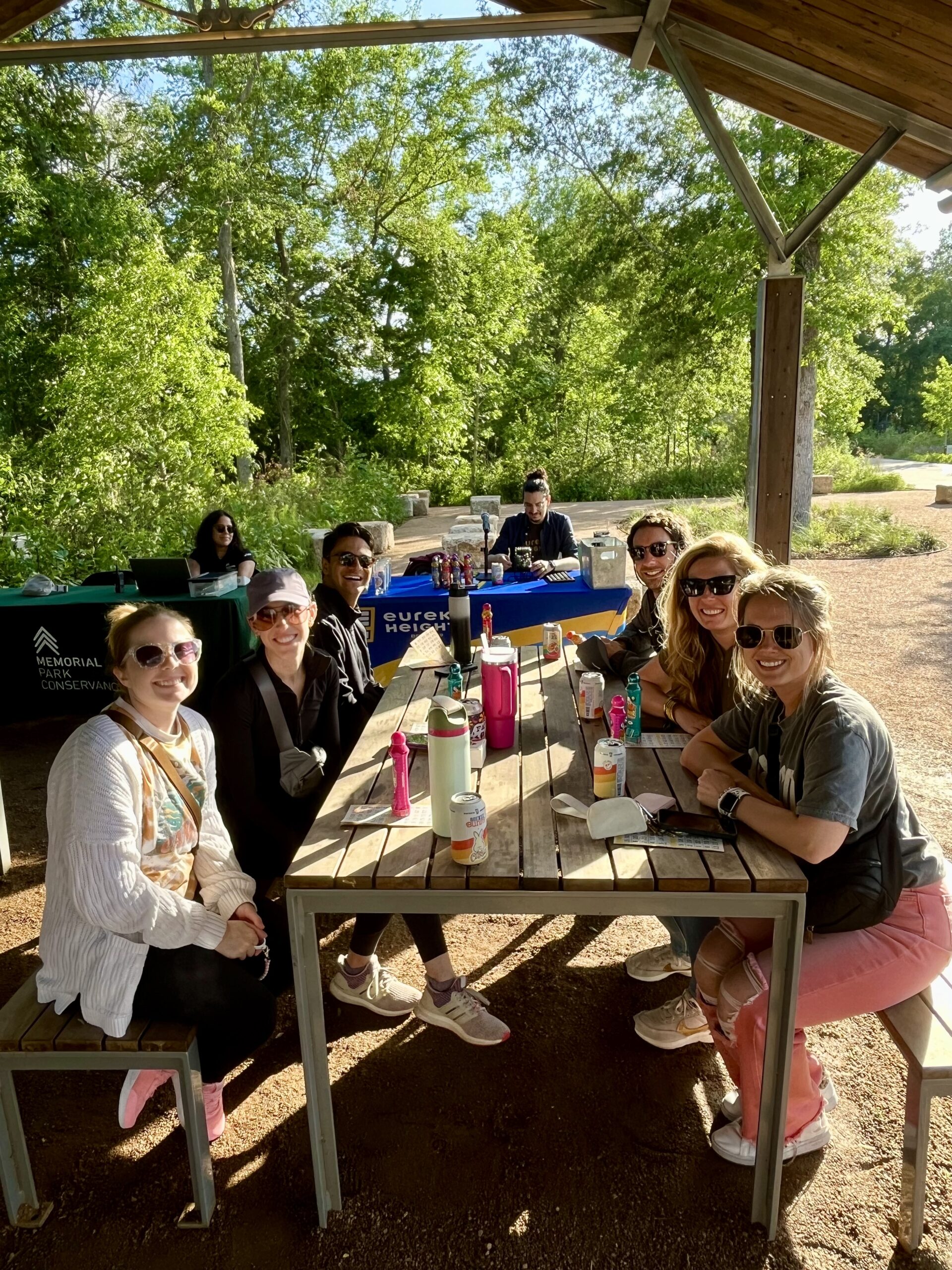Discover
History
Memorial Park’s history is not only connected to the history of Houston, but to Texas and beyond.
Memorial Park History
Long before the Memorial Park Conservancy came into existence, the Park benefitted from the leadership and interest of passionate conservationists, beginning with Miss Ima Hogg, sister to the Park’s benefactors, Will and Mike Hogg. The original deed of sale to the city specified that the land remain “for park purposes only,” stipulating that should this not be respected, the land would return to Hogg family ownership or that of their heirs. The Park was to be named to honor the soldiers who fought in World War I and trained in Camp Logan, today known as Memorial Park; Camp Logan was one of a handful of training camps established to train and convert members of the National Guard to become U.S. military service members.
For fifty years, Miss Ima served as guardian of the Park, saving it from numerous potential encroachments, including proposals for oil wells and construction of Houston’s once-famous Astrodome stadium. She faced down over a hundred such proposals, some with prominent local backers, enabling Memorial Park to remain a haven for Houstonians.
Through the Memorial Park Conservancy, the dreams of a world-class park fostered by illustrious Houstonians of the past are being continued by some of Houston’s most dedicated environmentalists of the present. The Conservancy keeps our Park free for everyone to use, while serving the recreational needs of Houstonians and conducting public education about green space preservation. Thanks to conservation programs during its 90 years of existence, the Park has retained much of its original character, while meeting the recreational needs of a growing city.

Historical Timeline
The “Mother of Texas” Jane Long’s diary recounts camping with a group of travelers headed to San Antonio in the “pinery” that is now the area of Memorial Park.
The Reinerman family establishes a homestead comprising much of the Park’s current land. It remains with members of the Reinerman family until 1883.
Mayor Horace Baldwin Rice, nephew of William Marsh Rice, strongly endorses the idea of acquiring a large park along Buffalo Bayou “that will for all time be of sufficient magnitude for our people”
The United States enters the First World War, and the War Department leases 7,600 acres of forested land on Buffalo Bayou to establish a training base named Camp Logan. The Camp trains 70,000 soldiers, housing 30,000 at any given time, and is a social center of Houston. Nearly 1,000 Camp Logan soldiers lose their lives during the war and over 6,200 are wounded. There are stories of heroism and bravery associated with Camp Logan. Among them, the 370th regiment, after training at Camp Logan, go on to serve with the French military and become the most decorated in all of WWI. There are also stories of tragedy associated with the Camp, including the Houston Mutiny and Riot which took place on the night of August 23, 1917.
When Camp Logan is deserted, Catherine Mary Emmott writes to the Houston Chronicle suggesting that “the city buy some of the land and turn it into a park in memory of the boys.” She becomes a tremendous advocate for the cause.
Will and Mike Hogg, with minority owner Henry Stude, buy two tracts of former Camp Logan land and sell the acreage to the city at cost. In May, the City of Houston officially establishes Memorial Park in memory of the soldiers who trained there. The Hogg’s sister, Miss Ima Hogg, assumes the role of guardian of the Park, saving it from numerous encroachments over the years. Acclaimed landscape architects Hare & Hare are hired to develop a plan for the Park which calls for an 18-hole golf course, scenic drives, trails for hikers and “nature students,” bridle paths, and an amphitheater.
The Works Progress Administration puts over 500 men to work on building the golf course. Landscape architect John Bredemus called it “my greatest golf course ever.” The adjacent clubhouse becomes a place to see and be seen. Green fees were 35 cents on weekdays and 50 cents on weekends.
Mr. and Mrs. H.C. Weiss donate an additional 8 adjoining acres on the west side of the Park to the City. Years later, this becomes the location for an archery range, a popular pastime.
Trail riders on the Salt Grass Trail camp overnight in the Park on their way to the Houston Livestock Show and Rodeo, beginning a lively annual tradition.
Hogg Bird Sanctuary, a 15.5 acre park at Memorial Drive and Westcott, is donated to the City of Houston by Ima Hogg to be a nature preserve.
The city develops the Houston Arboretum and Nature Center within Memorial Park to provide nature education as well as an urban wildlife sanctuary.
Inspired by Houstonian Seymour Lieberman, commonly referred to as the “Father of Jogging”, Al Lawrence begins coaching runners for area high-school cross country meets, spearheading the popularity of jogging in the Park. The sport receives an additional boost from the 1972 Olympics.
Upon the passing of Miss Ima Hogg, a group of stalwart conservationists –Terry Hershey, Sadie Gwin Blackburn, Dr. John D. Staub and Frank C. Smith, Jr.–continue to protect the Park from new intrusion.
The Seymour Lieberman Exer-Trail is established. Today, over 10,000 people each day use the Exer-Trail.
Three Quarter Time, a red steel sculpture by Ben Woitena, is installed on the median of Memorial Drive near the Living Bridge.
Sadie Gwin Blackburn assists in developing a larger group to provide guidance and stewardship and organizes the Memorial Park Advisory Committee.
Sarah Emmott, member of the Texas Conservation Hall of Fame, writes the cherished book “Memorial Park: A Priceless Legacy.”
Bush Grove is dedicated in honor of President George H.W. Bush and First Lady Barbara Bush
The Memorial Park Advisory Committee becomes the Memorial Park Conservancy, established as a 501(c)(3) nonprofit organization.
An initial master plan is formed for the Park and funds are successfully raised to build the pedestrian Living Bridge, renovate the Alkek Tennis Center and construct the Outer Loop Trail.
The Living Bridge opens, providing a safe pedestrian crossing over Memorial Drive.
A devastating drought arrives. More than half of the trees in Memorial Park are irrevocably damaged. A reforestation plan is put into motion.
Houston City Council approves the annexation of Memorial Park into the boundaries of the Uptown TIRZ #16, resulting in a significant funding stream for the Park. A Master Plan process is embarked upon.
The Cullen Running Trails Center opens on the south side of Memorial Drive at the base of the Living Bridge
Houston City Council approves the long-range Master Plan for Memorial Park. In December, ground breaks on the inaugural project, Eastern Glades.
Memorial Park Conservancy takes over the daily maintenance and operations of Memorial Park
In October, Eastern Glades Phase I, the first project of the Master Plan, opens to the public and includes new restrooms, more parking, and a number of environmentally friendly efforts.
The Kinder Foundation donates $70 million to Memorial Park Conservancy in the largest single parks grant in Houston history to accelerate the Master Plan, leading to the creation of the Ten-Year Plan.
Ground breaks on the second phase of Eastern Glades which will include greenspace for picnicking and passive recreation, a boardwalk, a lake and wetlands, a commemorative pedestrian entrance near the location of the original entrance into Camp Logan, and a second set of new restrooms.




